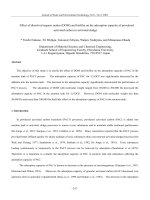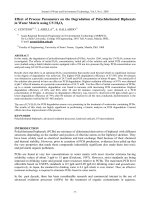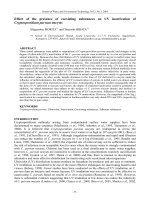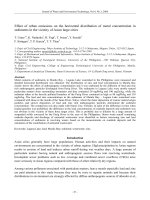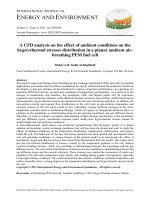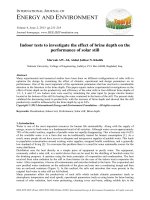The Effect of Aesthetic on the Usability of Data Visualization pdf
Bạn đang xem bản rút gọn của tài liệu. Xem và tải ngay bản đầy đủ của tài liệu tại đây (1.24 MB, 9 trang )
The Effect of Aesthetic on the
Usability of Data Visualization
Nick Cawthon and Andrew Vande Moere
The University of Sydney, Australia
,
Abstract
Aesthetic seems currently under represented in most
current data visualization evaluation methodologies.
This paper investigates the results of an online survey of
285 participants, measuring both perceived aesthetic as
well as the efficiency and effectiveness of retrieval tasks
across a set of 11 different data visualization techniques.
The data visualizations represent an identical
hierarchical dataset, which has been normalized in terms
of color, typography and layout balance. This study
measured parameters such as speed of completion,
accuracy rate, task abandonment and latency of
erroneous response. Our findings demonstrate a
correlation between latency in task abandonment and
erroneous response time in relation to visualization’s
perceived aesthetic. These results support the need for an
increased recognition for aesthetic in the typical
evaluation process of data visualization techniques.
Keywords User/Machine Systems: Human
Factors, Information Interfaces: Graphical User
Interfaces.
1. Introduction
Aesthetics is a concept that relates to the beauty in
both nature and art, as something that enlivens or
invigorates both body and mind, awakening the senses.
Aesthetics can be better understood by investigating
general preferences in art [1], from interpreting results in
experimental psychology [2] or by assuming that the
subjective world is of a logical, mathematical nature [3].
Aesthetics is also tightly integrated in current society, as
our environment contains an abundant amount of
artifacts that were specifically designed with aesthetic
criteria in mind. Ranging from historical buildings to
modern software applications, the integration of
aesthetics typically aims to stimulate the desire,
positively influence the first impression, encourage
repeated usage or even overwhelm its audience.
Aesthetic has already been investigated in related
fields, including user experience, product design and
human computer interaction. To date, the most relevant
aesthetic measures in the data visualization field have
been described in the study of graph drawing, the
automatic generation of network diagrams. This research
delineates the minimization of bends, edge crossings and
the maximizing of angles, orthogonality and symmetry as
effectors on aesthetic style [4]. Here, aesthetics is
investigated as a directly measurable and quantifiable
entity, rather than the reflection of personal judgment.
Within the graph drawing discipline, as well as in most
of the data visualization field, aesthetics is primarily
considered for its potential positive influence on task
effectiveness, as there seems less concern for the
experiential nature of aesthetic judgment.
Other research projects demonstrate the advantages
of aesthetic design on interactive systems [5-8].
Tractinsky [9] illustrates the importance of investigating
whether a user discriminates between systems based
upon aesthetic, in that beauty and usability represent a
special type of relationship. More specifically, aesthetic
judgment has shown to improve the efficiency and
effectiveness of task performance reflected by a reduced
completion time and error rate [7, 10, 11]. Chen [12]
states aesthetic to be one of the most important problems
that the data visualization field faces today. We further
believe there is a need to understand why users find
specific visualizations visual attractive, and how such
judgment can influence task performance. Aesthetic
plays a role in a system’s overall attractiveness [13], as
an significant incentive for initial use. Accordingly, the
popularity of data visualization can only benefit by
embracing aesthetic as a persuasive medium.
As research considers effectiveness and efficiency as
important factors in judging visualization techniques,
aesthetic quality should equally be considered. However,
aesthetic is often seen as an add-on, implemented at the
very end of the development process. In fact, aesthetic in
the context of data visualization is still not methodically
defined, and seems underrepresented in today’s typical
evaluation study methodologies [12]. This research
attempts to fill this gap by investigating the relationship
between aesthetic in data visualization and measures of
effectiveness and efficiency, here supplemented with
task abandonment and erroneous response time metrics.
2. Background
This study should not be considered a popularity or
‘beauty contest’ of different methods of visualization.
Nor is it to be perceived as a competition staged to find
the fastest and most accurate technique. Instead, this
study investigates the correlation between task
abandonment, erroneous response times and perceived
aesthetic. Error rate and completion time measurements
are well known in data visualization evaluations [11, 14].
Task abandonment is a metric of usability primarily
11th International Conference Information Visualization (IV'07)
0-7695-2900-3/07 $20.00 © 2007
referenced within the field of web analytics, the studying
of user behavior on the Internet. The focus of statistical
investigation for web analytics has matured from the
basic counting of website visitors to deeper insight
behind the metrics generated by long-term user behavior.
As companies publish an inordinate amount of
information on their websites, the potential increases for
visitors (and potential customers) to exit due to a feeling
of frustration. A user-centered perspective on a website’s
usability is critical to prevent lost revenue. Analytic
applications place emphasis to isolate potential
‘bottlenecks’, delays in progress for tasks such as multi-
part form completion. It has been proven that removing
such bottlenecks reduces the number of abandoning
visitors. Duration and rate of task abandonment indicates
to what duration a user is willing to persist with an
interface before giving up altogether.
Tractinsky et al. [15] have validated results of an
aesthetic perception study for web interfaces by
implicitly measuring response latencies. In this study, we
isolate the erroneous response latency as the length of
time taken by a participant who generates an incorrect
answer. Independent from the efficiency metric, an
erroneous response latency indicates the level of
investment a participant is willing to take for an
seemingly difficult task. We considered this measure in
conjunction with the above mentioned task abandonment
response, as participants can terminate their ‘struggle’ at
any point in time, but some instead choose to extend
their search, pertaining in finding the correct answer.
In this study, these measures, originally defined for
website evaluations, have been leveraged in the
assessment of data visualization. Drawing analogy from
the linear task of an online shopping cart with an
information retrieval function within data visualization,
the core of the efficiency and effectiveness metrics are
similarly applicable. Our hypothesis is that aesthetic will
have an effect on extending the latency of task
abandonment and duration of erroneous response time.
This is potentially important because these factors
correlate with a level of user patience, the duration in
which interaction occurs before either completion or
abandonment. As data visualization continues to
commercialize, so does its exposure to the greater
masses, making further understanding of the holistic user
experience all the more crucial.
3. Methodology
As illustrated in Figure 1, this study is based on 11
different data visualization techniques that were chosen
on following grounds: general availability, whether the
application software is relatively easily obtainable,
installable and configurable by non-experts, and
visualization technique diversity. Accordingly, the
chosen set contains visualization techniques ranging
from traditional TreeMaps and network diagrams to
more elaborate, or creative, floral-inspired
representations. All data visualizations represent an
identical hierarchical dataset.
3.1. Dataset
Figure 1. Tested data visualization methods
(see Appendix for authors and affiliations).
The chosen dataset comprises of a file directory
structure containing subfolders, vacation images, and
text files. This particular dataset was chosen to achieve
an identifiable level of familiarity to the user, who
should focus on the representation, instead of on the
dataset’s meaning. Visualizations in the survey dataset
were normalized according to the following criteria:
• Color – all color palettes were generated from a
single, identical set of 11 colors, selected from
the default palette used in the folder icon of
Windows Explorer.
• Size, Scale & Positioning – For each technique, a
single screenshot was generated, measuring 600
by 600 pixels. Data visualizations were centered
on both a horizontal and vertical axis. Each
visualization was scaled in size to the maximum
that legibility would allow.
• Typography – Text labels were replaced by an
identical black colored, 10 point Arial font face
in all visualization techniques.
TreeMap IcicleTree SpaceTree
Windows Explorer BeamTrees StarTree
Dendogram Tree Polar View StepTree
Botanical Viewer SunBurst
11th International Conference Information Visualization (IV'07)
0-7695-2900-3/07 $20.00 © 2007
ugly neutral beautifu
l
Figure 2. Online survey interface element used to evaluate the relative level of aesthetic
appearance for different information visualization techniques as a group.
• Conveyance – All data visualization techniques
conveyed the same information of the identical
hierarchical dataset of 53 files and folders. In the
case of SpaceTree and Windows Explorer, some
folders needed to be collapsed, due to vertical
space constraints.
• Interaction – All data visualization techniques
could be perceived only as static images, as no
interaction was allowed. This was to deliberately
avoid any influence of the interaction metaphor
on the visual judgment of beauty, and to focus
solely on the display as a sort of ‘art painting’.
3.2. Online Survey
The findings published in this paper are based on an
online survey and part of a larger study on the role of
aesthetic within data visualization [16]. The online
survey method was utilized for the following reasons:
• Validation - A large number of participants were
needed due to a desire to validate both a diverse
set of different displays methods along with a
number of corresponding usability metrics, and
the expected variability of aesthetic subjective
judgment throughout age groups, psychosocial
factors and cultures. With 11 different methods
randomized against 14 questions of varying
difficulty, the minimum amount of participants
needed for a valid random dispersal of questions
to visualizations was 154.
• Native delivery method - the majority of the
native delivery methods for data visualizations
are through use of a computer screen or a plug-in
displayed within a desktop-based application.
Registration pages collected personal information
regarding the age, gender, design experience, primary
and secondary languages, computer application usage,
and preferred computing platform of each participant. It
is expected that these identifiers may provide further
insight into subjective aesthetic of data visualizations in
accordance to demographic and psychosocial factors.
Participants were recruited via online message boards,
mailing lists and weblog postings across a variety of
different demographic targets. Each survey was designed
to require about twenty-five minutes, while participants
offered no direct or indirect compensation. The web
browser dimensions were mandated to be a minimum of
1024x768 pixels in dimension through the use of
Javascript. All images were pre-loaded during the
registration process to ensure instantaneous display.
3.3. Procedure
The online survey consisted of two separate
sections, prefaced with small textual descriptions and
simple examples beforehand. These two sections, labeled
aesthetic ranking and task performance were presented
to users in a randomized order. This format follows an
order-varied ANOVA method in order to sensitize
against results from one section affecting the other. Each
participant received a unique ID, which tracked the order
of sections as well as their randomized set of
visualization techniques and corresponding task retrieval
questions. Instead of using the full set of 11
visualizations, randomized subsets of 7 were selected for
each participant, which were also varied in their order of
display. A typical subset, with two retrieval questions per
visualization technique, was limited to 7 in the interest of
reducing the required survey completion time, as well as
not to overwhelm the participant’s cognitive capacity.
3.3.1. Aesthetic Ranking – The aesthetic ranking
section of the survey was comprised of two individual
evaluation tasks. This section was limited to the visual
representation only, as all typographic labels were
removed from the display. Participants were asked to
perform the following rankings:
• Individual ranking – For the individual ranking
task, participants were first asked to pause for six
seconds to “reflect on the aesthetic quality of the
image” as they “would with a painting or
illustration”, while looking at a visualization
with all text labels removed. After this specified
duration of reflection, the interface elements for
the survey were presented alongside the display.
Using keyboard or mouse, each participant was
then asked to rate the perceived beauty of the
shown visualization display by using a slider bar
interface (see Figure 3). In order to provide a
11th International Conference Information Visualization (IV'07)
0-7695-2900-3/07 $20.00 © 2007
more instinctual experience, while no numeric
indication of this input was shown.
• Group
ranking – Subsequently, participants were
requested to perform a relative group ranking.
This relational method was chosen to evaluate
visualizations against one-another. It allowed
participants to directly compare visualization
techniques within a self-chosen group, and even
permitted for similar assessments to overlap
when participants deemed different techniques as
equally aesthetic. This approach specifically
aimed to detect clustering and commonalities
between multiple visualizations, grouping them
accordingly. Participants were invited to rank
and group displays by dragging and dropping
thumbnails on a horizontal scale (see Figure 2)
based on their perceived, relative level of
aesthetic quality. The extremes of this scale were
labeled ‘ugly’ and ‘beautiful’, similar to the ends
of the slider bar in the individual ranking task.
However, using the ‘drag and drop’ method,
participants were more encouraged to group
together different visualization techniques
because of perceived similarities or reasoning.
Figure 3. Survey interface element for
determining quantitative individual aesthetic.
3.3.2. Task Performance – In addition to the
subjective aesthetic response questions, a series of
question and answer tasks were asked of each
participant. These queries centered around 14 structure
and attribute-related questions of the dataset consisting
of a standardized file and folder hierarchy.
The 14 questions were randomized in order and
application towards the 7 different visualization
techniques, with each display being used to answer two
queries. This randomization was required to eliminate a
display performing poorly due to variations in the
difficulty of questions. All visualizations thus needed to
contain sufficient information to answer all possible
questions. Each question was displayed along with a
multiple-choice selection of 6 answers, including a
‘cannot tell’ option, which specifically aimed to measure
the abandonment response. Participants were instructed
to complete each task as quickly as possible, as their
response times were being recorded.
4. Results
An eight-week testing period resulted in 285 valid
participants (n=285). A participant’s results were omitted
if they were considered as duplicate, indicated by the
combination of the provided name and the recorded IP
address. Participants who did not complete all sections or
questions within the survey, regardless of order, had their
results removed. Any responses that took under three
seconds or over 100 seconds were removed, to avoid
rushed answers or responses that were possibly
influenced by external disturbances. Over 50% of the
total online survey visitors canceled their process once
reaching the registration page. Subsequently,
approximately 45% of the successfully registered survey
participants were removed due to duplication, process
abandonment or response impropriety. The 285 valid
participants originated from 37 different countries as
diverse as Peru, Nepal and Sweden. The call for
participation had been spread heavily amongst those with
formal design backgrounds, due to selected postings
amongst information architecture and design community
websites. However, due to the viral nature of the
Internet, the occupation of participants ranged widely
and participants have shown an interest in visualization
from typical data-related research fields ranging from
Epidemiology and Economics to Library Sciences. The
survey continues to run until July of 2008 in order to
provide further data from an increasingly varied pool of
participants.
4.1. Aesthetic Ranking
Aesthetic ranking was calculated on a scale of 0 to
100, with 100 indicating an optimal aesthetic value
(rightmost of either scale in Figures 2 and 3, previous
page). An individual mean and group mean of aesthetic
rank was calculated for each of the 11 visualizations, as
illustrated in Figure 4. The confidence interval of .05%
determined the validity and variance of each
visualization response set, a previously unreported
measure of aesthetic preference investigations.
80
70
60
50
40
30
20
10
0
TreeMap
Botan. Viewer
SunBurst
Icicle Tree
SpaceTree
Win. Explorer
BeamTree
StarTree
Dendo.Tree
Polar View
StepTree
Figure 4. Individual (leftmost of each pair,
darker) and group aesthetic (rightmost, lighter)
rankings, with overlaying confidence intervals.
The SunBurst method was associated to the highest
level of perceived beauty, averaging a ranking of 58 and
11th International Conference Information Visualization (IV'07)
0-7695-2900-3/07 $20.00 © 2007
69 of a possible value of 100 for the individual and group
ranking tasks, respectively (see Figure 4). On the other
end of the spectrum, BeamTrees averaged 36 and 32 for
each aesthetic ranking task. Logical groupings of
visualization techniques by categorical appearance did
not necessarily occur. For example, rankings for the
three-dimensional visualization methods (those which
utilize a perspective of depth, e.g. – Botanical Viewer,
StepTree, BeamTrees) were inconsistent. In addition,
TreeMap and IcicleTree, similar in their orthogonal,
space-filling technique, received significantly different
average rankings, with TreeMap scoring continually
toward the bottom of the pack in both ranking queries.
Additionally, the similar graph node-linking techniques
of SpaceTree and PolarView did not appear as like
elements in the participant responses.
The highest discrepancy in confidence interval was
detected in Botanical Viewer (±3.86, ±4.86) for both
individual and group ranking, although existing on an
insignificant scale. This consistency in results might be
explained by the relatively short time span between the
individual and group aesthetic ranking tasks. The slightly
higher scores for the group ranking tasks are likely due
to conceptual differences in the interface elements (e.g.
allowing overlap) that were used to rate the visualization
techniques.
Rate of
Correct response (%)
Correct response
time (seconds)
Error response
time (seconds)
Rate of
Abandonment (%)
Abandon. Response
time (seconds)
TreeMap .32
35.0
37.3
.38
34.5
Botan.Viewer .43
39.6
40.6
.32
35.3
SunBurst .84
23.2
47.1
.07
37.8
IcicleTree .81
22.0
41.2
.12
42.4
SpaceTree .73
20.8
40.9
.06
52.1
Win. Explorer .79
21.8
38.0
.08
38.6
BeamTree .28
27.7
35.6
.55
29.9
StarTree .81
23.4
43.5
.07
50.8
Dendo.Tree .74
25.7
43.2
.11
43.2
Polar View .69
27.6
37.2
.15
35.0
StepTree .42
39.0
40.6
.35
29.6
Table 1. Measures of effectiveness, efficiency,
erroneous response and task abandonment.
The visualization technique showing the widest
range of discrepancy (although not evident in averaged
ranking) between the group and the individual metric is
the SunBurst, showing an 8% increase between the
individual and group ranking averages. In the individual
ranking, where the interface of a slider bar was used
(Figure 3), the extreme Low ranking for all 11
visualizations reached an absolute of 0, compared to
none of the collective rankings. This extreme in ranking
was on the High end of the scale as well, with 4
visualizations receiving an optimal 100 score a total of
15 times. In contrast, the group evaluation method
proved to be more susceptible to reach an absolute
minimum or maximum value.
4.2. Effectiveness
The effectiveness of three-dimensional displays
proves to be consistently low in comparison to two-
dimensional displays. All three examples, Botanical
Viewer, StepTree and BeamTrees are ranked in the
lowest four displays in terms of task accuracy (43%,
42% and 28% correct, respectively). TreeMap, a long-
established data mapping technique finished amongst
this group with a correct response rate of 32%.
Contrarily, SunBurst displays an accuracy rate of 84%,
surpassing the mark of 81% received by Windows
Explorer, disproving the notion that the familiarity of
Explorer would result in the highest effectiveness of any
method.
4.2.1. Order Variance – It is of note that the order
variance of SpaceTree’s perceived aesthetic ranking
improved the most dramatically (+6.5%) when
participants were presented with the data retrieval tasks
first. We will revisit this finding in the analysis section of
this paper.
4.3. Efficiency
Mirroring effectiveness, there proved to be
correlations found in measures of efficiency. These
metrics were averaged from all correct response times
within the valid range of between 3 and 100 seconds.
The three-dimensional layouts of Botanical Viewer and
StepTree proved to be the slowest. Accordingly, these
two specific techniques were likely the most affected by
the total lack of user interaction.
The color-coded IcicleTree, performed 5.6 seconds
faster to the structurally identical space-filling layout
Dendogram Tree. The familiarity of Windows Explorer,
neither made it the most effective nor the most efficient
technique, with SpaceTree averaging a full one-second
faster in correct response time (20.8 seconds). Data
visualization techniquess that read top-to-bottom (i.e.
Dendogram Tree, Windows Explorer, IcicleTree) were
not found to be significantly slower than those reading
left-to-right. Separation of demographics in accordance
to the participant’s primary language (those which read
top-to-bottom versus left-to-right) and preferred
technique has not yet been performed.
The particular swirling technique PolarView, similar
in layout to the space-filling StarTree, measured 4.2
seconds longer for data retrieval, also resulting in a lower
efficiency average of approximately 12%. This supports
findings from the field of graph drawing, which
recommends against the use of edge crossings [4] for
optimal usability. Conversely, PolarView received a
higher aesthetic rank, averaging second highest in the
group ranking task.
11th International Conference Information Visualization (IV'07)
0-7695-2900-3/07 $20.00 © 2007
BeamTrees, the technique that received the lowest
subjective aesthetic ranking and effectiveness,
participants recorded an average duration of 27.7
seconds per question. Amongst the dataset of 11 different
data visualization techniques, this ranks as approximately
an average time, placing BeamTrees in the middle of the
pack in terms of efficiency.
4.4. Latency in Erroneous Response
Complimenting accuracy ratios are timings of
erroneous response and speed of completion, measuring
the duration in which a participant probed in expectation
of retrieving the correct answer. The three-dimensional
techniques of Botanical Viewer and StepTree, two of the
more aesthetic, but lesser performing, visualization
techniques, show above average erroneous response
times of 40.6 seconds, which is comparable to methods
nearly twice their effectiveness.
BeamTrees, which showed an average ranking in
efficiency, displayed the shortest level of latency in
erroneous response, 35.6 seconds. In contrast,
participants were most inclined to spend time interacting
with SunBurst, the visualization technique that held the
highest rank of subjective aesthetic. SunBurst had the
highest percentage of correct response (84%), but also a
significantly longer duration (47.1 seconds) of erroneous
response.
4.5. Task Abandonment
Given SunBurst’s high accuracy rate, the rate of task
abandonment is expectedly low at less than 1%.
Reversing, over half the participants (55%) abandoned
questions associated with the BeamTrees visualization.
Participants attempted to decipher problems presented by
StarTree (50.8 seconds) and SpaceTree (52.1 seconds)
nearly twice as long as StepTree (29.6 seconds) or
BeamTree (29.9 seconds) before selecting ‘cannot tell’
as a conceding answer, showing a wide discrepancy in
abandonment times.
5. Analysis
SunBurst exemplifies the notion that ‘beautiful is
indeed usable [9, 17, 18]. This technique ranks the
highest in aesthetic and is one of the top performing
visualizations in both efficiency and effectiveness.
Conversely, visualization techniques that were both
efficient and effective did not necessarily embody
aesthetic beauty. Windows Explorer and SpaceTree, two
of the fastest and most accurate displays, were amongst
the lowest ranked aesthetically. In the case of Windows
Explorer, previous exposure to this widespread technique
may have created an element of bias in perceived beauty.
Furthermore, Botanical Viewer, among the highest
ranked visualization technique in terms of aesthetic,
performed poorly in the data retrieval tasks. Participants
took nearly twice as long in answering questions and
averaged approximately half the accuracy rate of
comparable techniques with similar aesthetic rank (i.e.
PolarView, SunBurst, StarTree).
The order variation of the aesthetic ranking and task
performance sections provided some discrepancy in
results. As mentioned in section 4.2.1, SpaceTree’s
perceived aesthetic ranking displayed the most
significant improvement (+6.5%) when participants were
presented with the data retrieval tasks first. SpaceTree
had the most efficient completion time of 20.8 seconds.
Accordingly, both the time and rate of abandonment for
this display method were highest and lowest,
respectively. SpaceTree recorded an abandonment time
of 52.1 seconds, with an extremely low abandonment
rate of .06%.
The SunBurst technique received the highest score
for both individual and group aesthetic ranking. In
addition, SunBurst averaged the second lowest rate of
task abandonment as well as the highest rate of correct
response. These results prove that participants who did
not immediately locate the correct answer felt
encouraged to continue their task. In contrast,
BeamTrees, the visualization technique with the lowest
aggregate aesthetic rank, averaged the highest rate of
task abandonment and was among the lowest in latency
of erroneous response. More than half of all participants
abandoned their task when confronted with BeamTrees.
We believe that these findings are significant in that they
correlate both a favorable and unfavorable aesthetic
ranking with metrics of task abandonment and erroneous
response.
6. Discussion
The notion that some data visualization techniques
are better suited to the abstraction of a specific dataset
type is worth exploring. For instance, SunBurst may not
have faired so well in aesthetic rank if the hierarchy of
files and folders had not been either so shallow or so
balanced. Some specialized data visualization techniques
have been shown to be capable to display datasets
containing over 19 million nodes [19], a capacity not
likely to be found amongst the chosen survey’s data
visualization set. Further work might include the
investigation as to which display method is suitable for
different dataset types (one, two, and multi-dimensional)
as well as a varying number of nodes.
According to Tufte [20], the human eye finds
nature’s color palette harmonious, and thus advises the
use of greens, blues, and browns for information
displays. If the existing earth-toned color palette was not
used in this online survey, results may not have been
equal. Perhaps BeamTrees would have not faired so
poorly in comparative aesthetic rank if the vibrant palette
was removed and the survey limited to a more utilitarian
greyscale.
Lastly, we acknowledge that the full advantage of
these data visualization techniques is leveraged through
the use of interaction. There exists both a joy and
aesthetic in playful interaction with a system which
raises the level of affect and emotion [16]. The
11th International Conference Information Visualization (IV'07)
0-7695-2900-3/07 $20.00 © 2007
availability of interactive features is also related to
perceived usability. For instance, BeamTrees, which
heavily relies on 3D navigation features to fully convey
the data mapping metaphor, was at a clear disadvantage
in its static, two-dimensional form. However, the
technical complexity of implementing 11 different data
visualization techniques in an online medium was
deemed impracticable for this study, especially as it
deliberately focused on the aesthetic quality of the data
mapping techniques, and less on the usability of the
according interaction methods. However, with the recent
proliferation of online data visualization tools (i.e.
swivel.com, IBM’s Many Eyes project [21]), such
endeavour could be imagined for future research.
7. Conclusion
In this paper, we have presented an online study that
correlated aesthetic and usability measures in the context
of data visualization. Through the subjective input from
285 participants, a quantitative ranking of data
visualization techniques were established. In addition to
determining relative beauty, participants were asked to
fulfil comparable retrieval tasks forcing them to utilize
these data visualization techniques. This methodology
returned objective metrics of efficiency and effectiveness
as well as measures of task abandonment and latency in
erroneous response.
This research introduced metrics of task
abandonment and erroneous response in correlation to a
level of aesthetic preference, demonstrating that these
new measures can be used to gauge user experience. It
also shows that aesthetic correlates with these values,
allowing for attractive visualizations to be looked at
more closely displaying a higher level of user patience.
This supports statements by Norman [22] in that, “it is
only through our emotions do we unravel problems, as
the human emotional system is intertwined with our
cognitive abilities”; if the user finds a positive affection
towards an object, our brains are encouraged to think
creatively in order to solve any problem in which the
object might present. Although Norman’s theory was
originally formulated towards the design of an industrial
product, this study shows similar correlations in the field
of data visualization. More specifically, the results
illustrate that the most aesthetic data visualization
technique also performs relatively high in metrics of
effectiveness, rate of task abandonment, and latency of
erroneous response. We argue that these results show
that aesthetic should no longer be seen as a cost to utility.
The original purpose of this research was to increase
the awareness of the positive role and purpose of
aesthetic in the design of data visualization techniques.
This paper focused on the effect in which data
visualization’s aesthetic has on specific measures of
usability. As aesthetic affects usability, this research
suggest that aesthetic should become an integral part of
evaluating data visualization techniques.
Acknowledgements
The authors would like to thank all participants who
took this survey. We would also like to also
acknowledge the authors of each visualization technique
for making their work available for the purposes of this
study. The online survey website can be visited at the
location: until July of 2008.
11th International Conference Information Visualization (IV'07)
0-7695-2900-3/07 $20.00 © 2007
Appendix
TreeMap
University of Maryland
C. Plaisant, B. Shneiderman, G.
Chintalapani, A. Aris
SunBurst
Georgia Tech University
J. Stasko
Botanical Viewer
Eindhoven University of Technology
E. Kleiberg, H. van de Wetering, J.J.
van Wijk
IcicleTree
INRIA Futurs/LRI
J. Fekete
SpaceTree
University of Maryland
J. Grosjean, C. Plaisant, B. Bederson
Windows Explorer
Microsoft Corporation
BeamTrees
Eindhoven University of Technology
F. van Ham
StarTree
Inxight Software
Dendogram Tree
INRIA Futurs/LRI
J Fekete
Reingold Tilfer Polar View
INRIA Futurs/LRI
J. Fekete
StepTree
Lulea University of Technology
T. Bladh
11th International Conference Information Visualization (IV'07)
0-7695-2900-3/07 $20.00 © 2007
References
[1] O. Conolly and B. Haydar, "Aesthetic Principles,"
The British Journal of Aesthetics, vol. 43, pp. 114-
125, 2003.
[2] R. Pickford, Psychology and Visual Aesthetics.
London: Hutchinson Educational Ltd., 1972.
[3] G. D. Birkhoff, Aesthetic Measure. Cambridge:
Harvard University Press, 1933.
[4] H. Purchase, J. A. Allder, and D. Carrington,
"Metrics for Graph Drawing Aesthetics," Journal of
Visual Languages and Computing, vol. 13, pp. 501-
516, 2002.
[5] B. J. Fogg, J. Marshall, O. Laraki, A. Osipovich, C.
Varma, N. Fang, J. Paul, A. Rangnekar, J. Shon, P.
Swani, and M. Treinen, "What Makes Web Sites
Credible?: A Report on a Large Quantitative Study,"
presented at Proceedings of the SIGCHI conference
on Human Factors in Computing Systems, Seattle,
Washington, U.S.A, 1998.
[6] J. Hartmann, "Assessing the Attractiveness of
Interactive Systems," in CHI '06 extended abstracts
on Human factors in computing systems. Montreal,
Quebec, Canada: ACM Press, 2006.
[7] M. Kurosu and K. Kashimura, "Apparent Usability
Vs. Inherent Usability," presented at CHI'95, New
York, 1995.
[8] R. Scha and R. Bod, "Computationele Esthetica,"
Informatie en Informatiebeleid, vol. 11, pp. 54-63,
1993.
[9] N. Tractinsky, "Aesthetics and Apparent Usability:
Empirically Assessing Cultural and Methodological
Issues," presented at CHI 97, New York, 1997.
[10] D. Ngo and J. G. Byrne, "Another Look at a Model
for Evaluating Interface Aesthetics," Int. J. Appl.
Math. Comput. Science, vol. 11, pp. 515-535, 2001.
[11] J. Stasko, R. Catrambone, M. Guzdial, and K.
McDonald, "An Evaluation of Space-Filling
Information Visualizations for Depicting Hierarchical
Structures " Int. J. Human-Computer Studies, vol. 53,
pp. 663-694, 2000.
[12] C. Chen, "Top 10 Unsolved Information
Visualization Problems," IEEE Computer Graphics
and Applications, pp. 12-16, 2005.
[13] A. Sutcliffe, "Heuristic Evaluation of Website
Attractiveness and Usability," in Interactive Systems:
Design, Specification, and Verification : 8th
International Workshop, Dsv-Is 2001, vol.
2220/2001: Springer Berlin / Heidelberg, 2004, pp.
183.
[14] A. Kobsa, "User Experiments with Tree Visualization
Systems," presented at Proceedings of the IEEE
Symposium on Information Visualization
(INFOVIS’04), Washington, DC, USA, 2004.
[15] N. Tractinsky, A. Cokhavi, and M. Kirschenbaum,
"Using Ratings and Response Latencies to Evaluate
the Consistency of Immediate Aesthetic Perceptions
of Web Pages," presented at Proceedings of the Third
Annual Workshop on HCI Research in MIS,
Washington, D.C., USA, 2004.
[16] N. Cawthon and A. Vande Moere, "A Conceptual
Model for Evaluating Aesthetic Effect within the
User Experience of Information Visualization," in
Tenth International Conference on Information
Visualisation (IV'06) London, England, 2006, pp.
374-382.
[17] K. Overbeeke and S. Wensveen, "Beauty in Use,"
Human-Computer Interaction, vol. 19, pp. 367-369,
2004.
[18] M. G. Petersen, O. S. Iversen, P. G. Krogh, and M.
Ludvigsen, "Aesthetic Interaction: A Pragmatist's
Aesthetics of Interactive Systems," presented at
Proceedings of the 2004 conference on Designing
interactive systems: processes, practices, methods,
and techniques, Cambridge, MA, USA, 2004.
[19] L. Beaudoin, M. A. Parent, and L. Vroomen, "
Cheops: A Compact Explorer for Complex
Hierarchies," presented at Visualization '96, San
Francisco, CA, USA, 1996.
[20] E. Tufte, Envisioning Information. Cheshire, Conn.
U.S.A.: Graphics Press, 1990.
[21] "Many Eyes." . Accessed March
2007.
[22] D. Norman, Emotional Design - Why We Love (or
Hate) Everyday Things. New York: Basic Books,
2004.
11th International Conference Information Visualization (IV'07)
0-7695-2900-3/07 $20.00 © 2007



